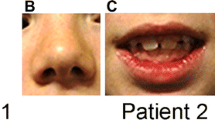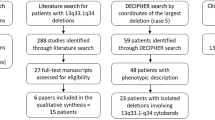Abstract
We have determined the parental origin of the deleted chromosome 22 in 29 cases of DiGeorge syndrome (DGS) using a CA-repeat mapping within the commonly deleted region, and in one other case by using a chromosome 22 short arm heteromorphism. The CA-repeat was informative in 21 out of 29 families studied and the deleted chromosome was of maternal origin in 16 cases (72%). When these data are pooled with recent results from the literature, 24 de novo DGS, velo-cardio-facial syndrome (VCFS) and isolated conotruncal cardiac disease deletions are found to be of maternal origin and 8 of paternal origin, yielding a χ2 of 8 with a probability level lower than 0.01. These data, and review of the literature on familial DGS/VCFS and isolated conotruncal cardiopathies suggest that there is a strong tendency for the 22q11.2 deletions to be of maternal origin.
Similar content being viewed by others
References
Aubry M, Demczuk S, Desmaze C, Aikem M, Aurias A, Julien J-P, Rouleau GA (1993) Isolation of a Zinc finger gene consistently deleted in DiGeorge syndrome. Hum Mol Genet 2:1583–1587
Bowen P, Pabst H, Berry D, Collins-Nakai R, Hoo JJ (1986) Thymus deficiency in an infant with a chromosome t(18;22) (q12.2;p11.2)pat rearrangement. Clin Genet 29:174–177
Bucan M, Gatalica B, Nolan P, Chung A, Leroux A, Grossman MH, Nadeau JH, Emanuel BS, Budarf M (1993) Comparative mapping of 9 human chromosome 22q loci in the laboratory mouse. Hum Mol Genet 2:1245–1252
Burn J, Takao A, Wilson D, Cross I, Momma K, Wadey R, Scambler P, Goodship J (1993) Conotruncal anomaly face syndrome is associated with a deletion within chromosome 22q11. J Med Genet 30:822–824
Carey AH, Roach S, Williamson R, Dumanski JP, Nordenskjold M, Collins VP, Rouleau G, Blin N, Jalbert P, Scambler PJ (1990) Localization of 27 DNA markers to the region of human chromosome 22q11-pter deleted in patients with the DiGeorge syndrome and duplicated in the der22 syndrome. Genomics 7:299–306
Carey AH, Kelly D, Halford S, Wadey R, Wilson D, Goodship J, Burn J, Paul T, Sharkey A, Dumanski J, Nordenskjold M, Williamson R, Scambler PJ (1992) Molecular genetic study of the frequency of monosomy 22q11 in DiGeorge syndrome. Am J Hum Genet 51:964–970
Clementi M, Tenconi R, Turolla L, Silvan C, Bortotto L, Artifono L (1991) Apparent CHARGE association and chromosome anomaly: chance or contiguous gene syndrome. Am J Med Genet 41:246–250
Dallapiccola B, Marino B, Giannotti A, Valorani G (1989) DiGeorge anomaly associated with partial deletion of chromosome 22. Ann Genet 32:92–96
D'Angelo JA, Pillers DM, Rice ML, Jett PL, Beyl CO, Hayflick S, Magenis RE (1994) Tetralogy of Fallot associated with deletions in the DiGeorge region of chromosome 22 (22q11). Am J Hum Genet 55[Suppl]:A573
de la Chapelle A, Herva R, Koivisto M, Aula P (1981) A deletion in chromosome 22 can cause DiGeorge syndrome. Hum Genet57:253–256
Demczuk S, Desmaze C, Aikem M, Prieur M, LeDeist F, Sanson M, Rouleau G, Thomas G, Aurias A (1994) Molecular cytogenetic analysis of a series of 23 DiGeorge syndrome patients by fluorescence in situ hybridization. Ann Genet 37:60–65
Desmaze C, Scambler P, Prieur M, Halford S, Sidi D, LeDeist F, Aurias A (1993a) Routine diagnosis of DiGeorge syndrome by fluorescent in situ hybridization. Hum Genet 90:663–665
Desmaze C, Prieur M, Amblard F, Aikem M, LeDeist F, Demczuk S, Zucman J, Plougastel B, Delattre O, Croquette M-F, Brevière G-M, Huon C, Le Merrer M, Mathieu M, Sidi D, Stephan J-L, Aurias A (1993b) Physical mapping by FISH of the DiGeorge critical region (DGCR): involvement of the region in familial cases. Am J Hum Genet 53:1239–1249
Driscoll DA, Budarf ML, Emanuel BS (1992a) A genetic etiology for DiGeorge syndrome: consistent deletions and microdeletions of 22q11. Am J Hum Genet 50:924–933
Driscoll DA, Spinner NB, Budarf ML, McDonald-McGinn DM, Zackai EH, Goldberg RB, Shprintzen RJ, Saal HM, Zonana J, Jones MC, Mascarello JT, Emanuel BS (1992b) Deletions and microdeletions of 22q11.2 in Velo-Cardio-Facial Syndrome. Am J Med Genet 44:261–268
Driscoll DA, Salvin J, Sellinger B, Budarf ML, McDonald-McGinn DM, Zackai EH, Emanuel BS (1993) Prevalence of 22q11 microdeletions in DiGeorge and velocardiofacial syndromes: implications for genetic counselling and prenatal diagnosis. J Med Genet 30:813–817
El-Fouly MH, Higgins JV, Kapur S, Sankey BJ, Matisoff DN, Costa-Fox M (1991) DiGeorge anomaly in an infant with deletion of chromosome 22 and dup(9p) due to adjacent type II disjunction. Am J Med Genet 38:569–573
Emanuel BS, Budarf ML, Sellinger B, Goldmuntz E, Driscoll DA (1992) Detection of microdeletions of 22q11. 2 with fluorescence in situ hybridization (FISH): diagnosis of DiGeorge syndrome (DGS), velo-cardio-facial (VCF) syndrome; CHARGE association and conotruncal cardiac malformations. Am J Hum Genet 51:A3
Faed MJW, Robertson J, Swanson Beck J, Cater JI, Bose B, Madlom MM (1987) Features of DiGeorge syndrome in a child with 45, XX, −3, −22, +der(3), t(3;22)(p 25:q11). J Med Genet 24:225–234
Forejt J, Gregorova S (1992) Genetic analysis of genomic imprinting: An imprintor-I gene controls inactivation of the paternal copy of the mouse Tme locus. Cell 70:443–450
Goldmuntz E, Driscoll D. Budarf ML, Zackai EH, McDonald-McGinn DM, Biegel JA, Emanuel BS (1993) Microdeletions of chromosomal region 22q11 in patients with congenital conotruncal cardiac defects. J Med Genet 30:807–812
Greenberg F, Crowder WE, Paschall V, Colon-Linares J-C, Lubianski B. Ledbetter DH (1984) Familial DiGeorge syndrome and associated partial monosomy of chromosome 22. Hum Genet 65:317–319
Greenberg F, Elder FFB, Haffner P, Northrup H, Ledbetter DH (1988) Cytogenetic findings in a prospective series of patients with DiGeorge anomaly. Am J Hum Genet 43:605–611
Haas OA, Argyriou-Tirita A, Lion T (1992) Parental origin of chromosomes involved in the translocation t(9;22). Nature 359:414–416
Hajianpour MJ, Lamb A, Coyle M (1994) Intrafamilial and interamilial variability of phenotype in familial velo-cardio-facial syndrome Am J Hum Genet 55[Suppl]:A1805
Hall JG (1990) Genomic imprinting: review and relevance to human diseases. Am J Hum Genet 46:857–873
Hall JG (1993) CATCH 22. J Med Genet 30:801–802
Holder SE, Winter RM, Kamath S, Scambler PJ (1993) Velocardiofacial syndrome in a mother and daughter: variability of the clinical phenotype. J Med Genet 30:825–827
Kelley RI, Zackai EH, Emanuel BS, Kistenmacher M, Greenberg F, Punnett HH (1982) The association of the DiGeorge anomaly with partial monosomy of chromosome 22. J Pediatr 101:197–200
Kelly D, Goldberg R, Wilson D, Lindsay E, Carey A, Goodship J, Burn J, Cross I, Shprintzen RJ, Scambler P (1993) Confirmation that the Velo-Cardio-Facial syndrome is associated with haplo-insufficiency of genes at chromosome 22q11. Am J Med Genet 45:308–312
Keppen LD, Fasules JW, Burks AW, Gollin SM, Sawyer JR, Miller CH (1988) Confirmation of autosomal dominant transmission of the DiGeorge malformation complex. J Pediatr 113:506–508
Lagrue A, Griscelli C (1984) Aplasie et hypoplasie thymique (syndrome de DiGeorge). In: Hitzig G, Hitzig W (eds) Déficits immunitaires hérédiraires et acquis. Doin Paris, pp 113–125
Lipson AH, Yuille D, Angel M, Thompson PG, Vandervood JG, Beckenham EJ (1991) Velocardiofacial (Shprintzen) syndrome: an important syndrome for the dysmorphologist to recognize. J Med Genet 28:596–604
Lupski JR, Langston C, Friedman R, Ledbetter DH, Greenberg F (1991) DiGeorge anomaly associated with a de novo Y;22 translocation resulting in monosomy del(22)(q11.2). Am J Med Genet 40:196–198
Marineau C, Aubry M, Julien JP, Rouleau GA (1992) Dinucleotide repeat polymorphism at the D22S264 locus. Nucleic Acids Res 20:1430
Mascarello JT, Bastian JF, Jones MC (1989) Interstitial deletion of chromosome 22 in a patient with the DiGeorge malformation sequence. Am J Med Genet 32:112–114
McLean MAJSD, Saal HM, Spinner NB, Emanuel BS, Driscoll DA (1993) Velo-cardio-facial syndrome intrafamilial variability of the phenotype. Am J Dis Child 147:1212–1216
Meinecke P, Beemer FA, Schinzel A, Kushnick T (1986) The velo-cardio-facial (Shprintzen) syndrome: clinical variability in eight patients. Eur J Pediatr 145:539–544
Pinto MR, Pinto Leite R, Areias A (1989) Features of Turner's and DiGeorge's syndromes in a child with an X;22 translocation. J Med Genet 26:778–780
Piussan C, Mathieu M, Boudaillez B, Schinzel S (1994) Noonan like appearance and familial deletion of the 22q11 Shprintzen-DiGeorge critical region. Am J Hum Genet 55[Suppl]:A501
Pivnick EK, Wilroy RS, Summitt JB, Tucker B, Herrod HG, Tharapel AT (1990) Adjacent-2 disjunction of a maternal t(9;22) leading to duplication 9pter-q22 and deficiency of 22pter-q11.2. Am J Med Genet 37:92–96
Puder KS, Humes R, Gold RB, Bawle E, Lamb AN, Goyert GL (1994) Prenatal diagnosis of interrupted aortic arch prompting familial diagnosis of DiGeorge/Velocardio facial syndrome utilizing FISH techniques. Am J Hum Genet 55[Suppl]:A1669
Ravnan JB, Chen E, Golabi M, Lebo RV (1994) Analysis of 22q11. 2 deletions by FISH in a series of velocardiofacial syndrome patients. Am J Hum Genet 55[Suppl]:A658
Reis A, Dittrich B, Greger V, Buiting K, Lalande M, Gillessen-Kaesbach G, Anvret M, Horsthemke B (1994) Imprinting mutations suggested by abnormal DNA methylation patterns in familial Angelman and Prader-Willi syndromes. Am J Hum Genet 54:741–747
Riggins GJ, Zhang F, Warren ST (1994) Lack of imprinting of BCR. Nature Genet 6:226
Rohn RD, Lefell MS, Leadem P, Johnson D, Rubio T, Emanuel BS (1984) Familial third-fourth pharyngeal pouch syndrome with apparent autosomal dominant transmission. J Pediatr 105:47–51
Scambler PJ, Carey AH, Wyse RKH, Roach S, Dumanski JP, Nordenskjold M, Williamson R (1991) Microdeletions within 22q11 associated with sporadic and familial DiGeorge syndrome. Genomics 10:201–206
Scambler PJ, Kelly D, Lindsay E, Williamson R, Goldberg R, Shprintzen R, Wilson DI, Goodship JA, Cross IE, Burn J (1992) Velo-cardio-facial syndrome associated with chromosome 22 deletions encompassing the DiGeorge locus. Lancet 39:1138–1139
Schwanitz G, Zerres K (1987) Partial monosomy 22 as result of an X/22 translocation in a newborn with DiGeorge syndrome. Ann Genet 30:80–84
Seaver LH, Pierpont JW, Erickson RP, Donnerstein RL, Cassidy SB (1994) Pulmonary atresia associated with maternal 22q11. 2 deletion: possible parent of origin effect in the conotruncal anomaly face syndrome. J Med Genet 31:830–834
Shprintzen RJ, Goldberg RB, Young D, Wolford L (1981) The Velo-Cardio-Facial syndrome: a clinical and genetic analysis. Pediatrics 67:167–172
Steele RW, Limas C, Thurman GB, Schuelein M, Bauer H, Bellanti JA (1972) Familial thymic aplasia, attempted reconstitution with fetal thymus in a millipore diffusion chamber. N Engl J Med 287:787–791
Stevens CA, Carey JC, Shigeoka AO (1990) DiGeorge anomaly and velocardiofacial syndrome. Pediatrics 85:526–530
Strong WB (1968) Familial syndrome of right-sided aortic arch, mental deficiency, and familial dysmorphism. J Pediatr 73:882–888
Weksberg R, Shen DR, Fei YL, Song QL, Squire J (1993) Disruption of insulin-like growth factor 2 imprinting in Beckwith-Wiedemann syndrome. Nature Genet 5:143–150
Williams MA, Shprintzen RJ, Goldberg RB (1985) Male-to-male transmission of the velo-cardio-facial syndrome: a case report and review of 60 cases. J Craniofac Genet Dev Biol 5:175–180
Wilson DI, Cross IE, Goodship JA, Coulthard S, Carey AH, Scambler PJ, Bain HH, Hunter AS, Carter PE, Burn J (1991) DiGeorge syndrome with isolated aortic coarctation and isolated ventricular septal defect in three sibs with a 22q11 deletion of maternal origin. Br Heart J 66:308–312
Wilson DI, Goodship JA, Burn J, Cross IE, Scambler PJ (1992) Deletions within chromosome 22q11 in familial congenital heart disease. Lancet 340:573–575
Wilson D, Burn J, Scambler P, Goodship J (1993) DiGeorge syndrome: part of CATCH 22. J Med Genet 30:852–856
Wraith JE, Super M, Watson GH, Phillips M (1985) Velo-cardiofacial syndrome presenting as holoprosencephaly. Clin Genet 27:408–410
Young D, Shprintzen RJ, Goldberg RB (1980) Cardiac malformations in the velocardiofacial syndrome. Am J Cardiol 46:644–648
Author information
Authors and Affiliations
Rights and permissions
About this article
Cite this article
Demczuk, S., Lévy, A., Aubry, M. et al. Excess of deletions of maternal origin in the DiGeorge/Velo-cardio-facial syndromes. A study of 22 new patients and review of the literature. Hum Genet 96, 9–13 (1995). https://doi.org/10.1007/BF00214179
Received:
Revised:
Issue Date:
DOI: https://doi.org/10.1007/BF00214179




